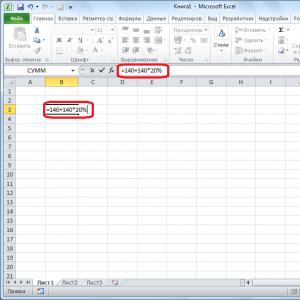The formula for finding the coordinates of the midpoint of a segment. How to find the coordinates of the midpoint of a line
Initial geometric information
The concept of a segment, like the concept of a point, line, ray and angle, refers to the initial geometric information. The study of geometry begins with these concepts.
Under "initial information" is usually understood as something elementary and simple. In understanding, perhaps this is so. Nevertheless, such simple concepts are often found and are necessary not only in our daily life, but also in production, construction and other spheres of our life.
Let's start with the definitions.
Definition 1
A segment is a part of a straight line bounded by two points (ends).
If the ends of the segment are points $ A $ and $ B $, then the formed segment is written as $ AB $ or $ BA $. This segment contains the points $ A $ and $ B $, as well as all points of the straight line lying between these points.
Definition 2
The midpoint of a segment is the point of a segment that divides it in half into two equal segments.
If this is the point $ C $, then $ AC \u003d CB $.
The measurement of a segment is performed by comparison with a certain segment taken as a unit of measurement. The most commonly used is a centimeter. If in a given segment a centimeter is stacked exactly four times, then this means that the length of this segment is $ 4 $ cm.
Let's introduce a simple observation. If a point divides a segment into two segments, then the length of the entire segment is equal to the sum of the lengths of these segments.
The formula for finding the coordinates of the midpoint of a segment
The formula for finding the coordinates of the midpoint of a line segment refers to the course of analytical geometry on a plane.
Let's define coordinates.
Definition 3
Coordinates are defined (or ordered) numbers that indicate the position of a point on a plane, surface, or space.
In our case, the coordinates are marked on a plane defined by the coordinate axes.
Figure 3. Coordinate plane. Author24 - online exchange of student papers
Let's describe the picture. A point called the origin is selected on the plane. It is denoted by the letter $ O $. Two straight lines (coordinate axes) are drawn through the origin of coordinates, intersecting at right angles, and one of them is strictly horizontal, and the other is vertical. This situation is considered common. The horizontal line is called the abscissa axis and is denoted by $ OX $, the vertical line is called the $ OY $ ordinate axis.
Thus, the axes define the $ XOY $ plane.
The coordinates of points in such a system are determined by two numbers.
There are different formulas (equations) that determine certain coordinates. Usually, in the course of analytical geometry, different formulas of lines, angles, segment lengths and others are studied.
Let's go directly to the formula for the coordinates of the midpoint of the segment.
Definition 4
If the coordinates of the point $ E (x, y) $ are the midpoint of the segment $ M_1M_2 $, then:
Figure 4. The formula for finding the coordinates of the midpoint of the segment. Author24 - online exchange of student papers
Practical part
Examples from the school geometry course are quite simple. Let's consider several main ones.
For a better understanding, let's first look at an elementary visual example.
Example 1
We have a drawing:
In the figure, the segments $ AC, CD, DE, EB $ are equal.
- What are the midpoints of $ D $?
- Where is the midpoint of the $ DB $ segment?
- point $ D $ is the midpoint of segments $ AB $ and $ CE $;
- point $ E $.
Let's look at another simple example where you need to calculate the length.
Example 2
Point $ B $ is the midpoint of segment $ AC $. $ AB \u003d 9 $ cm. How long is $ AC $?
Since m. $ B $ divides $ AC $ in half, then $ AB \u003d BC \u003d 9 $ see. Hence, $ AC \u003d 9 + 9 \u003d 18 $ see.
Answer: 18 cm.
Other similar examples are usually identical and focused on the ability to compare length values \u200b\u200band their representation with algebraic actions. Often in tasks there are cases when a centimeter does not fit an even number of times in a segment. Then the unit of measurement is divided into equal parts. In our case, the centimeter is divided by 10 millimeters. The remainder is measured separately by comparison with the millimeter. Let's give an example to demonstrate such a case.
After painstaking work, I suddenly noticed that the size of web pages is large enough, and if it goes on like this, then you can quietly and peacefully be brutalized \u003d) Therefore, I bring to your attention a short essay devoted to a very common geometric problem - on dividing a segment in this respect, and, as a special case, about dividing a segment in half.
This task, for one reason or another, did not fit into other lessons, but now there is a great opportunity to consider it in detail and slowly. The good news is that we will take some time off from vectors and focus on points and lines.
Line division formulas in this respectThe concept of dividing a segment in this respect
The concept of dividing a segment in this respect
Often there is no need to wait for the promised, we will immediately consider a couple of points and, the obvious incredible - a segment:
The problem under consideration is valid for both plane segments and space segments. That is, the demonstration segment can be placed as you like on a plane or in space. For ease of explanation, I've drawn it horizontally.
What are we going to do with this segment? This time cut. Someone is sawing a budget, someone is sawing a spouse, someone is sawing wood, and we will start to saw a segment in two. The segment is divided into two parts using some point, which, of course, is located directly on it:
In this example, the point divides the line in such a way that the line is half the length of the line. MORE we can say that the point divides the segment in the ratio ("one to two"), counting from the top.
In dry mathematical language, this fact is written as follows:, or more often in the form of the usual proportion:. The ratio of the segments is usually denoted by the Greek letter "lambda", in this case:.
The proportion is easy to compose in a different order: - this notation means that the segment is twice as long as the segment, but it has no fundamental significance for solving problems. You can do that, but you can do that.
Of course, the segment can be easily divided in some other respect, and as a reinforcement of the concept, the second example:
Here the ratio is true:. If we make up the proportion on the contrary, then we get:.
After we figured out what it means to divide the segment in this regard, let's move on to considering practical problems.
If two points of the plane are known, then the coordinates of the point that divides the segment in relation are expressed by the formulas: ![]()
Where did these formulas come from? In the course of analytical geometry, these formulas are strictly derived using vectors (where can we go without them? \u003d)). In addition, they are valid not only for the Cartesian coordinate system, but also for an arbitrary affine coordinate system (see the lesson Linear (non) dependence of vectors. Vector basis). Such is the universal task.
Example 1
Find the coordinates of a point dividing a segment in a ratio, if points are known ![]()
Decision: In this problem. Using the formulas for dividing a segment in this respect, we find a point: 
Answer:
Pay attention to the calculation technique: first you need to separately calculate the numerator and the denominator separately. The result is often (but not always) a three- or four-story fraction. After that, we get rid of the multi-storey fraction and carry out the final simplifications.
The task does not require building a drawing, but it is always useful to complete it on a draft:

Indeed, the ratio is satisfied, that is, the segment is three times shorter than the segment. If the proportion is not obvious, then the segments can always be measured stupidly with an ordinary ruler.
Equivalent second solution: in it the counting starts from a point and the relation is fair: ![]() (in human words, the segment is three times longer than the segment). According to the formulas for dividing a segment in this respect:
(in human words, the segment is three times longer than the segment). According to the formulas for dividing a segment in this respect: 
Answer:
Note that in the formulas, you need to move the coordinates of the point to the first place, since the little thriller started with that.
You can also see that the second way is more rational due to simpler calculations. Still, this problem is often solved in the "traditional" order. For example, if a segment is given by the condition, then it is assumed that you will make a proportion, if a segment is given, then "tacitly" means a proportion.
And I brought the second method for the reason that often the task condition is deliberately tried to confuse. That is why it is very important to carry out a rough drawing in order, firstly, to correctly analyze the condition, and, secondly, for verification purposes. It's a shame to make mistakes in such a simple task.
Example 2
Points are given ![]() ... To find:
... To find:
a) the point dividing the segment in relation;
b) the point dividing the segment in relation.
This is an example for a do-it-yourself solution. Complete solution and answer at the end of the tutorial.
Sometimes there are problems where one of the ends of the segment is unknown:
Example 3
The point belongs to the line segment. It is known that the segment is twice as long as the segment. Find a point if ![]() .
.
Decision: It follows from the condition that the point divides the segment in relation, counting from the top, that is, the proportion is fair:. According to the formulas for dividing a segment in this respect: ![]()
We do not currently know the coordinates of the point:, but this is not a particular problem, since they are easy to express from the above formulas. In general, it's not worth expressing anything, it is much easier to substitute specific numbers and carefully deal with the calculations: 
Answer:
To check, you can take the ends of the segment and, using the formulas in direct order, make sure that the ratio will actually result in a point. And, of course, of course, a drawing will not be superfluous. And in order to finally convince you of the benefits of a checkered notebook, a simple pencil and a ruler, I propose a tricky problem for an independent solution:
Example 4
Point . The segment is one and a half times shorter than the segment. Find a point if the coordinates of the points are known ![]() .
.
Solution at the end of the lesson. By the way, it is not the only one, if you go in a different way from the sample, it will not be a mistake, the main thing is that the answers coincide.
For spatial segments, everything will be exactly the same, only one more coordinate is added.
If two points of space are known, then the coordinates of the point that divides the segment in relation are expressed by the formulas:
.
Example 5
Points are given. Find the coordinates of a point belonging to a segment if it is known that ![]() .
.
Decision: From the condition follows the relation: ![]() ... This example is taken from a real test, and its author allowed himself a little prank (suddenly someone stumbles) - it was more rational to write the proportion in the condition as follows:
... This example is taken from a real test, and its author allowed himself a little prank (suddenly someone stumbles) - it was more rational to write the proportion in the condition as follows: ![]() .
.
According to the formulas for the coordinates of the midpoint of the segment:
Answer: ![]()
3D drawings for verification purposes are much more difficult to execute. However, you can always make a schematic drawing in order to understand at least the condition - which segments need to be correlated.
As for the fractions in your answer, don't be surprised, it's common. I have said it many times, but I will repeat: in higher mathematics, it is customary to wield ordinary right and wrong fractions. Answer in the form ![]() will do, but the option with improper fractions is more standard.
will do, but the option with improper fractions is more standard.
Warm-up task for an independent solution:
Example 6
Points are given. Find the coordinates of a point if it is known that it divides a segment in relation.
Solution and answer at the end of the lesson. If it is difficult to navigate the proportions, follow the schematic drawing.
In independent and control works, the examples considered are found both by themselves and as an integral part of larger tasks. In this sense, the problem of finding the center of gravity of a triangle is typical.
A kind of task where one of the ends of the segment is unknown, I do not see much sense in disassembling, since everything will look like a flat case, except that there are a little more calculations. Let's better remember the school years:
Line midpoint formulas
Even untrained readers may remember how to split a segment in half. The problem of dividing a segment into two equal parts is a special case of dividing a segment in this respect. The two-handed saw works in the most democratic way, and each neighbor at the desk gets the same stick:
At this solemn hour, the drums beat, welcoming the significant proportion. And general formulas ![]() miraculously transform into something familiar and simple:
miraculously transform into something familiar and simple: ![]()
A convenient moment is the fact that the coordinates of the ends of the segment can be rearranged painlessly: ![]()
In general formulas, such a luxurious number, as you know, does not work. And here there is no special need for it, so, a pleasant trifle.
An obvious analogy is valid for the spatial case. If the ends of a segment are given, then the coordinates of its midpoint are expressed by the formulas:
Example 7
The parallelogram is given by the coordinates of its vertices. Find the point of intersection of its diagonals.
Decision: Those interested can make a drawing. I especially recommend graffiti to those who have completely forgotten the school geometry course.
By a well-known property, the diagonals of a parallelogram are halved by their intersection point, so the problem can be solved in two ways.
Method one: Consider opposite vertices ![]() ... Using the formulas for dividing a segment in half, we find the midpoint of the diagonal:
... Using the formulas for dividing a segment in half, we find the midpoint of the diagonal:
The article below will highlight the issues of finding the coordinates of the midpoint of a segment if there are coordinates of its extreme points as the initial data. But, before starting to study the issue, we introduce a number of definitions.
Definition 1
Section - a straight line connecting two arbitrary points, called the ends of the line. As an example, let it be points A and B and, accordingly, segment A B.
If segment A B continues in both directions from points A and B, we get line A B. Then the segment A B is a part of the resulting line, bounded by points A and B. Segment A B unites points A and B, which are its ends, as well as a set of points lying between. If, for example, we take any arbitrary point K lying between points A and B, we can say that point K lies on the segment A B.
Definition 2
Segment length - the distance between the ends of the segment at a given scale (segment of unit length). The length of the segment A B is denoted as follows: A B.
Definition 3
Mid-point - a point lying on a segment and equidistant from its ends. If the midpoint of the segment A B is denoted by point C, then the equality will be true: A C \u003d C B
Initial data: coordinate line O x and non-coincident points on it: A and B. These points correspond to real numbers x A and x B. Point C - midpoint of segment A B: it is necessary to determine the coordinate x C.
Since point C is the midpoint of segment A B, the following equality will be true: | A C | \u003d | C B | ... The distance between points is determined by the module of the difference between their coordinates, i.e.
| A C | \u003d | C B | ⇔ x C - x A \u003d x B - x C
Then two equalities are possible: x C - x A \u003d x B - x C and x C - x A \u003d - (x B - x C)
From the first equality we derive the formula for the coordinates of the point C: x C \u003d x A + x B 2 (half the sum of the coordinates of the ends of the segment).
From the second equality we get: x A \u003d x B, which is impossible, since in the original data, mismatched points. Thus, formula for determining the coordinates of the midpoint of a segment A B with ends A (x A) and B (x B):
The resulting formula will be the basis for determining the coordinates of the midpoint of a segment on a plane or in space.
Initial data: rectangular coordinate system on the plane O x y, two arbitrary non-coinciding points with the given coordinates A x A, y A and B x B, y B. Point C is the midpoint of segment A B. It is necessary to determine the coordinates x C and y C for point C.
Let us take for analysis the case when points A and B do not coincide and do not lie on the same coordinate line or a straight line perpendicular to one of the axes. A x, A y; B x, B y and C x, C y - projections of points A, B and C on the coordinate axes (straight lines O x and O y).

According to the construction, the lines A A x, B B x, C C x are parallel; straight lines are also parallel to each other. Together with this, according to Thales' theorem, from the equality A C \u003d C B, the following equalities follow: A x C x \u003d C x B x and A y C y \u003d C y In y, and they in turn indicate that the point C x is the middle of the segment A x B x, and C y is the midpoint of the segment A y B y. And then, based on the formula obtained earlier, we get:
x C \u003d x A + x B 2 and y C \u003d y A + y B 2
The same formulas can be used in the case when points A and B lie on the same coordinate line or a straight line perpendicular to one of the axes. We will not conduct a detailed analysis of this case, we will consider it only graphically:


Summarizing all of the above, coordinates of the midpoint of the segment A B on the plane with the coordinates of the ends A (x A, y A) and B (x B, y B) defined as:
(x A + x B 2, y A + y B 2)
Initial data: coordinate system О x y z and two arbitrary points with given coordinates A (x A, y A, z A) and B (x B, y B, z B). It is necessary to determine the coordinates of point C, which is the midpoint of segment A B.
A x, A y, A z; B x, B y, B z and C x, C y, C z - projections of all specified points on the axis of the coordinate system.

According to Thales' theorem, the following equalities are true: A x C x \u003d C x B x, A y C y \u003d C y B y, A z C z \u003d C z B z
Therefore, the points C x, C y, C z are the midpoints of the segments A x B x, A y B y, A z B z, respectively. Then, to determine the coordinates of the midpoint of a segment in space, the following formulas are valid:
x C \u003d x A + x B 2, y c \u003d y A + y B 2, z c \u003d z A + Z B 2
The formulas obtained are also applicable in cases where points A and B lie on one of the coordinate lines; on a straight line perpendicular to one of the axes; in one coordinate plane or a plane perpendicular to one of the coordinate planes.
Determining the coordinates of the midpoint of a segment through the coordinates of the radius vectors of its ends
The formula for finding the coordinates of the midpoint of a segment can also be derived according to the algebraic interpretation of vectors.
Initial data: rectangular Cartesian coordinate system O x y, points with given coordinates A (x A, y A) and B (x B, x B). Point C is the midpoint of segment A B.
According to the geometric definition of actions on vectors, the following equality will be true: O C → \u003d 1 2 · O A → + O B →. Point C in this case is the intersection point of the diagonals of the parallelogram built on the basis of the vectors O A → and O B →, i.e. midpoint of the diagonals. The coordinates of the radius vector of the point are equal to the coordinates of the point, then the equalities are true: O A → \u003d (x A, y A), O B → \u003d (x B, y B). Let's perform some operations on vectors in coordinates and get:
O C → \u003d 1 2 O A → + O B → \u003d x A + x B 2, y A + y B 2
Therefore, point C has coordinates:
x A + x B 2, y A + y B 2
By analogy, a formula is determined for finding the coordinates of the midpoint of a segment in space:
C (x A + x B 2, y A + y B 2, z A + z B 2)
Examples of solving problems for finding the coordinates of the midpoint of a segment
Among the tasks involving the use of the formulas obtained above, there are both those in which the question of calculating the coordinates of the midpoint of the segment is directly involved, and those that involve bringing the given conditions to this question: the term "median" is often used, the goal is to find the coordinates of one from the ends of the segment, and also common problems on symmetry, the solution of which, in general, should also not cause difficulties after studying this topic. Let's consider typical examples.
Example 1
Initial data: on the plane - points with given coordinates A (- 7, 3) and B (2, 4). It is necessary to find the coordinates of the midpoint of the segment A B.
Decision
Denote the midpoint of the segment A B by point C. Its coordinates will be defined as the half-sum of the coordinates of the ends of the segment, i.e. points A and B.
x C \u003d x A + x B 2 \u003d - 7 + 2 2 \u003d - 5 2 y C \u003d y A + y B 2 \u003d 3 + 4 2 \u003d 7 2
Answer: coordinates of the middle of the segment A B - 5 2, 7 2.
Example 2
Initial data: the coordinates of the triangle A B C are known: A (- 1, 0), B (3, 2), C (9, - 8). It is necessary to find the length of the median A M.
Decision
- By the hypothesis of the problem, M is the median, and therefore M is the midpoint of the segment B C. First of all, we find the coordinates of the midpoint of the segment B C, i.e. point M:
x M \u003d x B + x C 2 \u003d 3 + 9 2 \u003d 6 y M \u003d y B + y C 2 \u003d 2 + (- 8) 2 \u003d - 3
- Since now we know the coordinates of both ends of the median (points A and M), we can use the formula to determine the distance between the points and calculate the length of the median A M:
A M \u003d (6 - (- 1)) 2 + (- 3 - 0) 2 \u003d 58
Answer: 58
Example 3
Initial data: in a rectangular coordinate system of three-dimensional space, a parallelepiped A B C D A 1 B 1 C 1 D 1 is given. The coordinates of the point C 1 (1, 1, 0) are given, and also the point M is defined, which is the middle of the diagonal B D 1 and has coordinates M (4, 2, - 4). It is necessary to calculate the coordinates of point A.
Decision
The diagonals of the parallelepiped have an intersection at one point, which is the midpoint of all the diagonals. Based on this statement, it can be borne in mind that the point M known from the conditions of the problem is the midpoint of the segment A C 1. Based on the formula for finding the coordinates of the midpoint of a segment in space, we find the coordinates of point A: x M \u003d x A + x C 1 2 ⇒ x A \u003d 2 x M - x C 1 \u003d 2 4 - 1 + 7 y M \u003d y A + y C 1 2 ⇒ y A \u003d 2 y M - y C 1 \u003d 2 2 - 1 \u003d 3 z M \u003d z A + z C 1 2 ⇒ z A \u003d 2 z M - z C 1 \u003d 2 (- 4) - 0 \u003d - 8
Answer: coordinates of point A (7, 3, - 8).
If you notice an error in the text, please select it and press Ctrl + Enter
How to find the coordinates of the midpoint of a line
First, let's figure out what the middle of a segment is.
The midpoint of a segment is a point that belongs to this segment and is at the same distance from its ends.
The coordinates of such a point are easy to find if the coordinates of the ends of this segment are known. In this case, the coordinates of the midpoint of the segment will be equal to half the sum of the corresponding coordinates of the ends of the segment.
The coordinates of the midpoint of a segment are often found by solving problems for the median, center line, etc.
Consider the calculation of the coordinates of the midpoint of the segment for two cases: when the segment is given on a plane and given in space.
Let a segment on a plane be given by two points with coordinates and. Then the coordinates of the middle of the PH segment are calculated by the formula:
![]()
![]()
Let the segment be given in space by two points with coordinates and. Then the coordinates of the middle of the PH segment are calculated by the formula:
![]()
![]()
![]()
Example.
Find the coordinates of the point K - the middle of the MO, if M (-1; 6) and O (8; 5).
Decision.
Since the points have two coordinates, it means that the segment is defined on the plane. We use the appropriate formulas:
Consequently, the middle of the MO will have coordinates K (3.5; 5.5).
Answer. K (3.5; 5.5).







